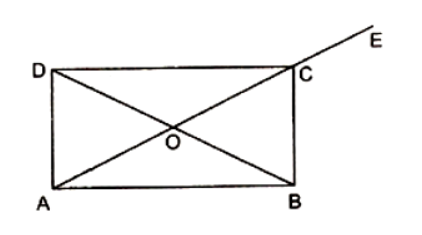In ABC, ∠A=500 and BC is produced to a point D. The bisectors of ∠ABC and ∠ACD meet at E. find ∠E.
To solve the problem step by step, we will follow these instructions:
Step 1: Understand the Problem
We have a triangle ABC where ∠A=50∘ and the side BC is extended to a point D. We need to find the angle ∠E where the angle bisectors of ∠ABC and ∠ACD intersect at point E.
Step 2: Draw the Diagram
Draw triangle ABC with ∠A=50∘. Extend line BC to point D. Mark the angles ∠ABC and ∠ACD.
Step 3: Identify Angles
- Let ∠ABC=B
- Let ∠ACD=C
Step 4: Use the Exterior Angle Theorem
According to the exterior angle theorem, the exterior angle ∠ACD is equal to the sum of the two opposite interior angles ∠A and ∠ABC:
∠ACD=∠A+∠ABC
Thus, we can write:
C=50∘+B
Step 5: Use the Angle Bisector Property
The angle bisector of ∠ABC divides it into two equal parts:
∠ABE=12∠ABC
Similarly, the angle bisector of ∠ACD divides it into two equal parts:
∠ACD=12∠ACD
Step 6: Set Up the Equations
From the angle bisector properties:
∠ABE=12B
∠ACD=12(50∘+B)
Step 7: Find ∠E
The angle ∠E can be expressed as:
∠E=∠ABE+∠ACD
Substituting the values we have:
∠E=12B+12(50∘+B)
Combine the terms:
∠E=12B+12⋅50∘+12B
∠E=12(B+50∘)
Step 8: Substitute B
Since B+C+50∘=180∘ (sum of angles in triangle ABC), we can find B:
B+(50∘+B)+50∘=180∘
2B+100∘=180∘
2B=80∘⟹B=40∘
Step 9: Calculate ∠E
Substituting B back into the equation for ∠E:
∠E=12(40∘+50∘)=12⋅90∘=45∘
Conclusion
Thus, the angle ∠E is 45∘.
We have a triangle ABC where ∠A=50∘ and the side BC is extended to a point D. We need to find the angle ∠E where the angle bisectors of ∠ABC and ∠ACD intersect at point E.
Draw triangle ABC with ∠A=50∘. Extend line BC to point D. Mark the angles ∠ABC and ∠ACD.
- Let ∠ABC=B
- Let ∠ACD=C
According to the exterior angle theorem, the exterior angle ∠ACD is equal to the sum of the two opposite interior angles ∠A and ∠ABC:
∠ACD=∠A+∠ABC
Thus, we can write:
C=50∘+B
The angle bisector of ∠ABC divides it into two equal parts:
∠ABE=12∠ABC
Similarly, the angle bisector of ∠ACD divides it into two equal parts:
∠ACD=12∠ACD
From the angle bisector properties:
∠ABE=12B
∠ACD=12(50∘+B)
The angle ∠E can be expressed as:
∠E=∠ABE+∠ACD
Substituting the values we have:
∠E=12B+12(50∘+B)
Combine the terms:
∠E=12B+12⋅50∘+12B
∠E=12(B+50∘)
Since B+C+50∘=180∘ (sum of angles in triangle ABC), we can find B:
B+(50∘+B)+50∘=180∘
2B+100∘=180∘
2B=80∘⟹B=40∘
Substituting B back into the equation for ∠E:
∠E=12(40∘+50∘)=12⋅90∘=45∘
Thus, the angle ∠E is 45∘.
Topper's Solved these Questions
Similar Questions
Knowledge Check
In △ABC ,∠A=40∘. If the bisector of ∠B and ∠C meet at a point O in the interior of the triangle, then ∠BOC is equal to:
त्रिभुज ABC में, ∠A=40∘ है |यदि कोण B तथा कोण C के द्विभाजक त्रिभुज के आतंरिक भाग में एक बिंदु O पर मिलते हैं, तो ∠BOC का क्या होगा ?A130∘B90∘C70∘D110∘
The side BC of ABC is produced to a point D. The bisector of ∠A meets side BC in L. If ∠ABC=300and ∠ACD=1150, then ∠ALC= 850 (b) 72120 (c) 1450 (d) none of these
View SolutionIn a parallelogram ABCD, AB=10cm, AD=6cm. The bisector of ∠A meets DC in E, AE and BC produced meet at F. Find the length C Foot
View SolutionIn ABC,∠A=900andAD is an altitude. Complete the relation BDDA=AB() .
View SolutionIn Fig. 71, if ABCD and CDEF, find ∠ACE
View SolutionIn Figure, ABCD is a rectangle in which diagonal AC is produced to E. If ∠ECD=1460, find ∠AOB

View SolutionIn a parallelogram ABCD, the bisector of ∠A also bisects BC at X Find AB:AD
View SolutionIn triangle ABC,∠B=45∘,∠C=55∘ and bisector of ∠A meets BC at a point D. Find ∠ADB and ∠ADC.
View Solution
